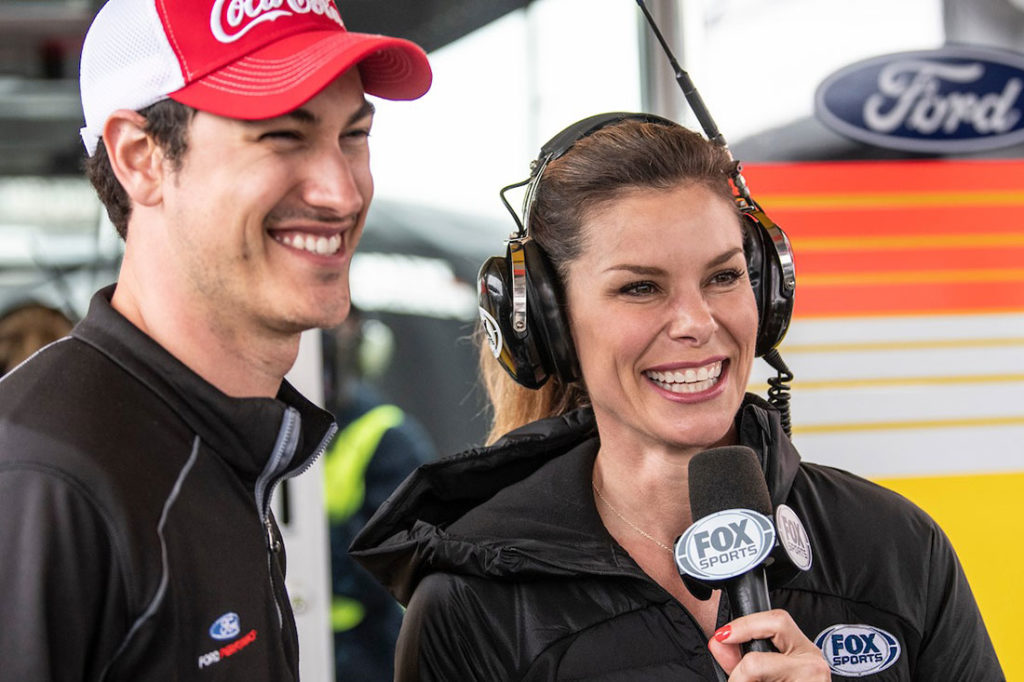Jamie Little, a broadcaster who has covered pit road at the biggest races in the country for more than a decade, emailed her boss, Jacob Ullman, this winter with a bold proposal. “I want to try play-by-play,” she told him.
She expected it would be the opening step in a dance that would take at least a year to complete. Ullman, Fox Sports senior vice president for production and talent development, had other ideas. He immediately thought of the ARCA series, the minor leagues to NASCAR’s major leagues. (NASCAR owns ARCA.) He got back in touch with her after a few days with a proposal even bolder: Not only would Little get a chance to do play-by-play, but she would become the voice of ARCA and call every race of that circuit’s 2021 season that airs on FOX Sports.

As the season-opening race approached, Little, Ullman and the racing officials who OK’d the move, all knew having a woman as the voice of the series would be unique. They didn’t know they’d be making history.
When Little was on the mic as the green flag dropped on the ARCA season in February, she was the first woman in history to do TV play-by-play for a national motorsports race. This is the latest of many firsts for Little. In 2004, she was the first woman to cover the pits on TV for the Indy 500. She was the first woman to cover a televised supercross and motocross event and was one of the first female reporters in X Games history.
Although she didn’t necessarily set out to be the first to do any of that, she relishes the opportunity to be a role model that the ARCA gig affords her.
“I felt the pressure of it being the first time for a woman, and it made me realize, OK, if I succeed in this role, it’s going to help women moving forward, because now as I break this glass ceiling, there’s no going back,” she says. “And I feel like I put that on me—I know I can do a good job, I want to do a good job, but maybe in this instance, I really want to do it for the women and for the future.”
***
As with any member of the gig economy, Little performs many roles. In addition to being the voice of ARCA, she covers pit road for NASCAR’s top three series for Fox. She works as a reporter for an A&E Network show called America’s Top Dog. She has written a book and appeared in several TV shows and movies. And along with her husband, Cody Selman with whom she has two children, she owns franchises of Jimmy John’s and Nothing Bundt Cakes.

Fiery and strong-willed, Little grew up in Lake Tahoe and Las Vegas, the daughter of a confident single mom upon whom she is quick to lavish praise. She believed her mom when she told her she could do anything and still believes it now.
“I was just a tough kid and never had a reason to doubt myself,” she says. “When I became an adult, I didn’t ever really question my ability.”
She worked on a ranch, and as a young girl made enough money in tips to buy her own horse. Animals were her first passion, and it’s easy to imagine she would have broken glass ceilings covering horse racing. But as a teenager, she fell in love with the sport of motocross. The competition, the danger, the speed, the passion, she loved all of it.
At races, the only women she saw were in the stands. In magazines, the only women were models. On TV, all the broadcasters were men. Why can’t I be the one telling their story? she asked herself.
She started asking others that question. She approached a cameraperson at a race, and soon she was traveling the country as a reporter on weekends and attending journalism school at San Diego State University during the week.
***
Being a NASCAR pit reporter puts her up close with the highest of highs and the lowest of lows. Little, 42, interviews drivers after thrilling, life-changing wins and after terrifying, life-threatening crashes. The confidence that allows her to ask tough questions in tough situations also makes her unafraid to take chances in her career.
Every major development in her professional life has been the result of her aggressively raising her hand to ask for an opportunity to show what she can do, from starting out in motocross to tracking down an ESPN producer and asking to be put on camera to emailing Ullman for a shot at play-by-play.
“I’ve never been worried about, oh gosh, what if the answer’s no,” she says. “I just don’t think that way.”
Career choices often involve deciding between getting ahead and doing what you love, and Little, 42, has consistently chosen to do what she loves. Looking back, she sometimes wonders if she should have raised her hand to cover stick-and-ball sports—that’s what auto racing enthusiasts call football, baseball and the rest.
Moving to traditional sports would be seen as a promotion. Certainly her profile would be higher if she covered the NFL instead of NASCAR because far more people watch the NFL than watch NASCAR. She’d likely make more money, too, for the same reason.
She was covering NASCAR for ESPN when ESPN stopped broadcasting races. ESPN offered her the chance to cover other sports, but she declined, opting to move to Fox instead to continue covering NASCAR. She says she made the right decision to stay in motorsports because she loves it, still, after all these years.
Little covered her seventh Daytona 500 in February and got butterflies in her stomach before it started as if it was her first.
“My advice is to find something you’re truly passionate about,” she says, “because you’re going to find such happiness in that. I never set out to say, ‘well, I want to make a bunch of money and I want to be on national TV.’ That was never in my mind, I just knew I love this, and I want to keep covering this.”
***
Motorsports becomes more diverse with each passing year. But from drivers to owners to broadcasters, it is still overwhelmingly male. Although it’s not fair, that puts a bright spotlight on women who are in high-profile roles. Little and other women are under scrutiny to prove their mettle in a way men are not.
“I hear it a lot, that ‘gosh I would want to do what you do, but there’s no way I could do it, there’s no way I could be on camera,’” she says. “I hear all the excuses. But as long as you believe that you can do it, then nothing should stop you.”
NASCAR fans are particularly prickly about the way their sport is covered. They sniff out poseurs who don’t know a lug nut from a peanut. That’s true for men, too, but it’s extra true for women. That means whoever was the first woman to move into a play-by-play role would face uncommon pressure.
Ullman was comfortable giving Little the ARCA job because he knew she had already built trust with fans, drivers and the rest of the racing community in her decade plus in front of the camera.
“She’s a great broadcaster by any measure, regardless of the sport she works on, regardless of her gender,” he says.
Little prepared for the opening ARCA race like she prepares for every race: By obsessively studying and forging relationships with key sources.
“I love the extra pressure,” Little says. “There’s no leniency here. You’ve got to nail that. You’ve got to do the job, but once you do, you’re in. I always felt that way. You’re looked at through a magnifying glass when you’re a female. People are waiting for you to say something wrong, or screw up in any way, but if you don’t, it’s like, ‘oh, OK, I can trust her.’”
Photos courtesy of FOX Sports










